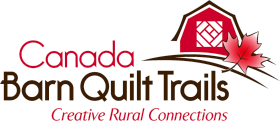Choose a Pattern:
The choice is limitless.
- Design your own block from a treasured family quilt, historical quilt, or your imagination.
- Create a block from an image or picture.
- Choose from Electric Quilt Company‘s four thousand patterns.
- Pick a theme or key word and search Internet for block pattern
 s
s
When designing fabric quilts that will inspire a series of barn quilts for a barn quilt trail, the painters and quilters should work closely together during the planning and design process.
Keep the designs simple. Designing your own patterns sounds great, but puts a burden on the quilters, the graphic designers, and the painters. Here is Denise Corneil talking about some of her personal inspirations.
Respect copyright.
Use designs that are in the public domain so you can use them for advertising, souvenirs, on-line publishing and posters without worry.
For those special designs, get permission from the creator. They will be thrilled to be featured in your project.
Choose Colours
- Choose bold, vibrant primary colours. Muted earth colours disappear on the side of the barn.
- Limit the number of colours per barn quilt block. Every new colour is a separate can of paint.
- Avoid natural autumn colors (grey, beige, muted tones).
- Sometimes geometric shapes need to be outlined with a black band. The farther the blocks are from viewers, the less detail is needed.
Learn about colour. Ask someone experienced with design to help choose a palette of quilt block colours. Colour choices get tricky when you are stitching a quilt (fabric); painting the barn quilts (paint); and creating computer graphics (digital). Your team will be juggling and matching each colour in three media!
Get Ready To Paint
Find a paint coordinator to handle planning, board preparation, painting, and sealing.
Find a paint monitor who will manage the paint, minimize waste, and clean brushes.
Work closely with your paint supplier.
Keep a paint diary.
Document all paint selections, colour recipes and the type of paint.
Ask your paint supplier to keep a detailed record of your paint selections.
Mobilize your volunteers
Volunteers step forward to paint barn quilts. It’s fun. It’s a marathon. Then it’s done.
If the painting project looks too big for a group of volunteers, then raise money to pay them. Boy Scouts, service groups, community groups – groups are not always enthused by yet another volunteer project but they sure love to participate in an easy fund raiser!
Choose a venue
Find the right place. Sometimes you can find the perfect places where all the steps can be performed.
Alas, that is not always possible. Moving the sheets is a lot of work. But sometimes it is necessary to prime and sand the sheets in one location and then haul them to the painting “studio”. Framing might have to be done somewhere else.
A clean dry barn works for priming, sealing, and the next step of framing the barn quilts. But a barn might not work for painting; the painters need bathrooms and the paint needs a warm dry place to cure. It’s handy if the installers can back in with a trailer to load sheets and finished quilt blocks.
Some projects are finding a location where they can set up for several months, allowing them to extend the project over several phases. Barn quilts can be commissioned. Or smaller blocks are painted and sold.
The painting studio needs:
- good lighting
- to be warm and dry
- drop cloths to protect the floor
- two 4′ X 8′ boards positioned on four saw horses so painters can reach across the boards,
- or position boards upright by leaning them against a wall
- or place on the floor if you are young and can paint on your knees. Not recommended!
Supply List
- two 4′ x 8′ 3/8” thick Medium Density Overlay plywood (MDO) for each quilt block. Sometimes called sign board. Available at some lumber yards. Call to reserve. Shop around.
- cardboard or plastic to cover the floor
- two pair saw horses or tables per quilt block
- sand paper and sanding blocks
- latex primer
- pencils for drawing patterns and artist erasers
- painter’s masking tape
- sticky notes for marking colours on the boards
- roller and paint tray for primer and sealer applicant only. Brushes work best for applying paint.
- brushes 2″ and 1″ angled for latex paints. Use food quality: foam brushes not recommended. Recommend one paint brush for each colour.
- pole extenders
- outdoor high quality latex paint
- small paint containers for decanting paint (e.g. cottage cheese containers for distributing paint to painters. Best not to dip into gallon paint cans)
- paint stir sticks
- paint brush spinner paper towel and clean cloths for dusting and wiping up spills
- sealant for finishing painted blocks. There is debate about what to use. Three Middlesex County projects used Weather Shield Low Gloss Sealer is a Home Builder Product with no issues. Home Hardware carries this product.
Tool List
- razor blade or craft knife
- paint can opener
- measuring tape
- large framing square (T-Square)
- yard/meter sticks
- squares
- string, tack, & nail or a carpenter’s protractor for drawing large circles
- 9 – 10 foot long straight edge to draw lines across the two boards
- pails for clean up
- computer projector for tracing non-geometric designs.
